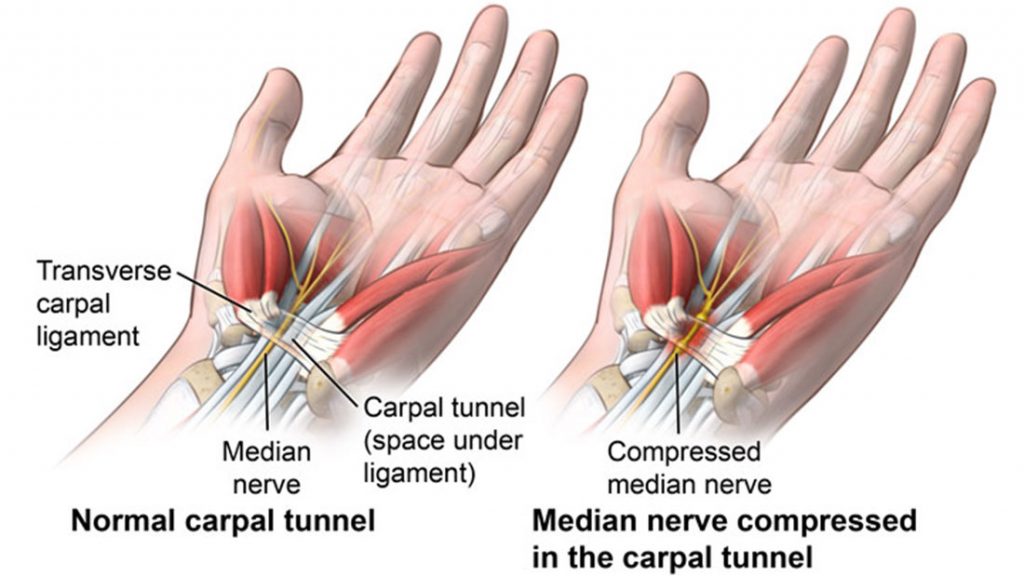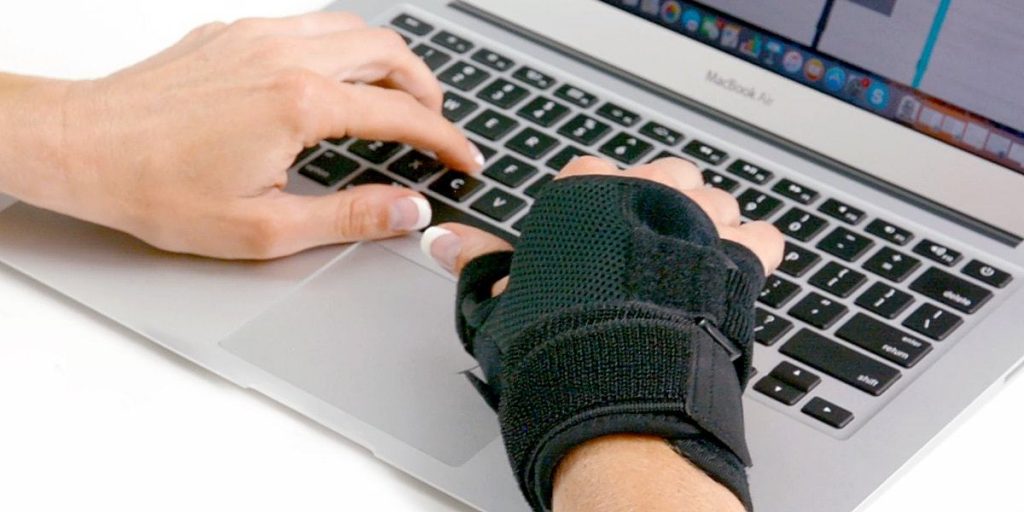Wrist pain is a very common problem that a lot of office workers report having.
Overuse, poor work environment, and lack of treatment are the usual causes of wrist pain.
It doesn’t necessarily mean you have Carpal Tunnel Syndrome (CTS).
Whether or not you have CTS, it’s worth taking some steps to improve your work environment.
This article will go through what is Carpal Tunnel Syndrome, common symptoms, and people at most risk.
We’ll also give you some treatment advice such as creating an ergonomic office and doing stretching exercises.
What is Carpal Tunnel Syndrome?

Carpal Tunnel Syndrome, often abbreviated as CTS, occurs in the wrist when pressure is exerted on the wrist for extended periods of time. The sufferer’s hands may feel numb, tingly, or painful.
They may also have trouble using their hands, gripping objects, and making a fist. Though it can be treated at home, it often takes months and months to get better.
What are the signs & symptoms of CTS?
We all have a tendency to dwell on our symptoms, and to worry. But if you have more than a couple of the below symptoms it’s time to make changes to your office habits.
- Numbness or tingling in your hands or fingers
- Pain in your hands or wrists
- A loss of strength or coordination in your hands and fingers
- You feel the sensation of ‘pins and needles’ often in your handsA weak thumb
- A difficulty gripping objects
How is CTS treated?

Treatments include wearing a wrist guard or wrist splint, which helps to take the pressure off of your wrist, and to alleviate the symptoms. This is no quick fix however, and you will not feel the benefits for a month, even after wearing the wrist splint throughout the days and nights.
Resting
Another way to treat Carpal Tunnel Syndrome is to isolate just what it is that is causing the pain, and to then cut down on the activity. This however may be difficult, if for example, the activity is crucial to your livelihood.
Medication
Another way to treat the issue is with painkillers and medication. Though this does not deal with the root cause of the problem, it does at least alleviate the symptoms somewhat.
Surgery
In serious cases surgery may be needed. This is usually when the patient is in a high level of pain and has not responded to any other forms of treatment.
Are particular groups at risk?
Particular groups of people are more at risk of Carpal Tunnel Syndrome than others.
- Those who have previously had troubles with their wrists
- Workers whose wrists are forced into repetitive actions and positions
- Anyone with a family history of CTS,
- Those who suffer from arthritis or diabetes
- Pregnant women
- Obese people
In the US, it is women in their 50s who suffer most from CTS. They are 3 times more likely than men to be diagnosed with CTS, whether or not they work in an office and with computers.
Treating CTS in the office
Take breaks
Repetitive movements and sitting in the same position for a long period of time can inflame the symptoms of CTS. It is difficult when you work in an office to take time away from the screen, to go for a short walk, make coffee, and have a break.
Ergonomic Practices
Ergonomics refers to the study of space and furniture, and how we are able to arrange our working environment so as to maximise our potential. It has particularly important implications for office workers, who are more and more being crammed into small spaces, and required to be more efficient. In such cases ergonomically optimised furniture and equipment is crucial for the office worker.
There is a huge range of ergonomic chairs available on the market, designed so as to prevent back problems when you are sitting still all day, and to help you to avoid getting CTS from putting too much pressure on your wrist for extended periods of time.
Some studies have even claimed that sitting in a poorly designed chair for 8 hours a day is worse for your health than smoking. In other studies they found that the productivity of their sample group increased by 17% after using ergonomic chairs.
A decent chair can cost a lot of money, so it is important that you do your research and find a chair that suits your body shape and work habits. One to one consultation is the best way to make sure your money goes on the right chair.
Another solution to CTS is the ergonomic keyboard. When buying a new computer most people don’t even think about the keyboard. They use the one that comes with the computer they buy, often for years at a time. CTS can be prevented by choosing an ergonomic keyboard. The shape, design, and materials of your keyboard influence how you move for 8 hours a day. Ergonomic keyboards prevent you from bending in unnatural ways, and aim to mirror the natural positions of your body.
CTS exercises and stretching

Stretching and exercises can help to prevent you from getting CTS. So why not take the time out of your working day to do these stretches and exercises?
- Shaking your hands in the morning can help to relive the pain and to get the blood flowing. Try it a few times throughout the day too, to keep the circulation going all day.
- A very simple one we can try, which becomes more difficult when our CTS flares up, is the thumb touch. Point each finger in turn to your thumb so that they connect. Try to do this for each finger on each hand for a few minutes.
- There’s a whole bunch of stretches you can try too, for instance, try making a fist, and then turn it into a stop sign, palm stretched out. This helps to stretch the wrist muscles.
- From the fist position try to spread your fingers out as wide as they will go, imagine you are trying to cover a face with your hand.
- Put your arms up against the wall and place your palms flat. Now push gently against your finger, stretching out the wrists.
Left untreated CTS can cause permanent damage to your wrists. Suffers may experience paralysis and chronic pain. Ergonomics offers a simple solution to this unnecessary blight. If you are an office professional you really should think carefully about your working environment. Up to 70% of the average workers day is spent sitting down in one place. It is your employers duty, and your own, to make sure you are fit for work, and that your working life is a healthy one.
Getting into healthy habits, moving about, sitting correctly, having the correct equipment, all of these things will help to increase your productivity. For employers this is crucial – in the UK alone, 137 million working days were lost to sickness. It is impossible to know how many sick days, and unproductive days CTS has caused. What we do know is that simple measures will greatly improve the situation.



